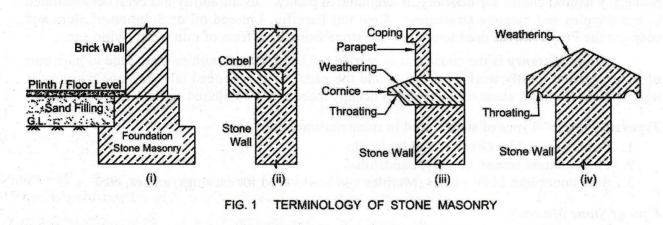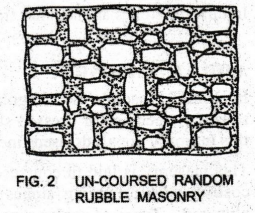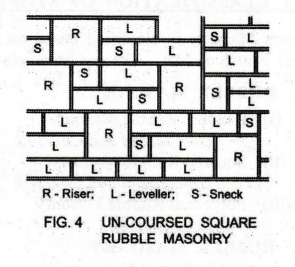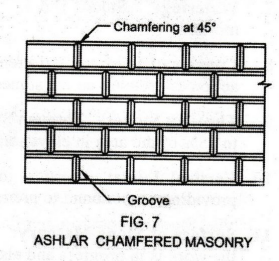Basic Civil & Mechanical Engineering: UNIT III: e. Masonry
Stone masonry
Types, Uses, Dressing, Terminology, Classification, Principles of Construction, Comparison
Stone is a natural choice for masonry, if available in plenty. Its durability has been demonstrated in our temples and massive structures.
STONE MASONRY
Stone
is a natural choice for masonry, if available in plenty. Its durability has
been demonstrated in our temples and massive structures. Coal tar, Paraffin,
Linseed oil or Solution of alum and soap are the Preservatives used to prevent
the stone from the effects of rain water, wind, etc.
Stone
Masonry is the construction carried out using
stones with mortar. Due to high cost of transportation, costly work of dressing
and the need for experienced labour, stone masonry is not popular. Further,
stone masonry walls occupy more space compared to brick masonry walls.
Types
of Stones: Types of stones used in stone masonry
are:
1.
Dense stones like Granites and Quartzite
2.
Fire-resistant stones, namely, Sandstones
3.
Soft stones like Lime Stones, Marbles and Slates used for carvings, arches,
etc.
Uses
of Stone Masonry
•
Foundation, floor, walls, lintels, columns, roofs, etc.
•
Walls, roofs, lintels for temples, monuments, etc.
•
For facing works in brick masonry to give a massive appearance.
1. DRESSING OF STONES
After
quarrying, stones are to be dressed for surface finish. Dressing of Stone is
the art of cutting the stones to the shape required for use in structures. It
is done at the quarry itself. The Quarry Dressing has the following advantages
in comparison to Site Dressing:
•
Cheap labour is available at the quarry site.
•
Freshly quarried stones contain some moisture called Quarry Sap. Hence, they
are comparatively soft and can be easily dressed.
•
It is possible to sort out the stones at the quarry for different works.
Irregular and rough portions of the stones can be removed then and there in the
quarry. Thus, the weights of the stones as well as the transportation of stones
are reduced.
Tools
Used for Dressing of Stones: Hammers, Chisels,
Axes, Punching Machine, etc.
1.
Types of Dressing
1.
Hammer Dressing: For Rubble Masonry, stones are roughly
dressed with hammers. The surface thus obtained is called Hammer-Dressed. The
stones are made roughly square or rectangular or polygonal. Lower and upper
surfaces of stones are almost dressed flat.
2.
Chisel Dressing: For good Ashlar Masonry, the faces of
stones are finely dressed by chisels. Its front face is dressed to rock face.
3.
Axed Finish: Axe is used for the dressing operation.
Axed Finish is employed in hard stones like Granites.
4.
Polished Finish: Granite and Marble take a good polish.
This is achieved manually or by the aid of polishing machines.
2. TERMINOLOGY OF STONE MASONRY [Figs. 1(i), (ii), (iii) and (iv)]

1.
Natural Bed: The surface on which the materials were
originally deposited in the formation of rock is known as Natural Bed.
2.
Plinth: Plinth is the projecting course at the Ground Floor
Level. It is used to indicate the height of Ground Floor Level from Ground
Level. The plinth course protects the interior of a building from rain water,
frost, etc.
3.
Corbel: Corbel is a stone piece provided in a wall. It
projects partly outside, which acts as bearing for the structural member such
as beam, roof truss, etc., resting on it.
4.
Cornice: It is placed at the top of a wall or ceiling near
the top of the building.
5.
Coping: Coping is a course of stone or brick placed on the
top of a Parapet wall. It protects the wall from seepage of rain water through
joints at the topmost course of the wall.
6.
Throating: Throating is a small groove cut on the underside of
Coping, Cornice and Sunshade. It is provided to discharge rain water without
trickling down to the walls.
7.
Weathering: Weathering is a slope provided to the
top surface of stones used for coping and cornice to drain-off the water immediately.
8.
Through Stones or Bond Stones: In stone masonry, some
long stones at regular intervals are placed through the full thickness of a
wall to develop bond. Such stones are known as Through Stones or Bond Stones.
9.
Jamb: Jamb is the vertical side of the opening of masonry
for door, window, etc. It may be plain or is provided with the recess to
receive the frames of door and window.
10.
Hearting: Hearting is a filled-up core of a rubble wall.
11.
Lintels or Heads: Lintels are the horizontal stones
provided at the top of the openings for doors, windows, etc.
3. CLASSIFICATION OF STONE MASONRY
Stone
Masonry is classified based on (i) Thickness of joints, (ii) Continuity of
courses and (iii) Finish of face. The two broad classifications of stone masonry
are:
1.
RUBBLE MASONRY
(i)
Random Rubble Masonry
Un-coursed
and Coursed
(ii)
Squared Rubble Masonry
Un-coursed
and Coursed
(iii)
Polygonal Rubble Masonry
2.
ASHLAR MASONRY
(i)
Ashlar Fine Masonry
(ii)
Ashlar Rough-Tooled Masonry
(iii)
Ashlar Rock or Quarry Faced Masonry
(iv)
Ashlar Chamfered Masonry
(v)
Ashlar Facing Masonry
1.
RUBBLE MASONRY
A
Rubble Stone Masonry wall is made up of stones of irregular sizes and shapes.
The stones from the quarry are broken into small sizes. These are directly used
in the construction work. In some cases, these stones may be shaped to suit the
requirement, with the help of hammers. These stones have rounded natural faces
or angular broken pieces.
Rubble
Masonry is further classified into three types. They are explained below.
(i)
Random Rubble Masonry
Random
Rubble Masonry uses stones of irregular shapes. The stones are arranged in a
random fashion. The joints are pointed to achieve a good appearance. Random
Rubble Masonry may be either Un-coursed or Coursed as explained below:
a)
Un-coursed Random Rubble Masonry
See
Fig. 2. It is the cheapest type of stone masonry. Stone blocks are not dressed,
but used as obtained from the quarry. They are of varying sizes and placed in
irregular pattern.

Vertical joints are not constructed in plumb. So, no regular courses are achieved.
Spaces between larger stones are filled with Spalls (small stones of irregular sizes) and packed in mortar. The appearance is not very pleasing.
Uses.
It is used for compound walls, godowns and walls of unimportant structures.
b)
Coursed Random Rubble Masonry
See
Fig. 3. In this, stones are hammer-dressed. Stones of equal height are used in
every course of the stone masonry. Thus, masonry work is carried out in courses.
Through Stones are used at every 2 meter distance in each course to form bond.

Uses: It is used for residential buildings, industrial buildings, compound walls, warehouses, etc.
(ii)
Square Rubble Masonry
In
this type, the stones are roughly squared with straight edges and sides with
hammer blows.
a)
Un-coursed Square Rubble Masonry (Fig. 4)
In
this type, the stones are of varying sizes of different heights, but with
straight edges and sides. They are laid in irregular pattern. Hence, no regular
courses are achieved.

Good
appearance is achieved by using Risers, Levellers and Snecks in a pattern as
shown. Snecks are used to prevent the occurrence of long continuous joints.
b)
Coursed Square Rubble Masonry (Fig. 5)

This
type of masonry also uses the same stones as used for un-coursed square rubble.
But, the work is carried out and levelled in courses of different heights.
Each course consists of Headers, Levellers and Through Stones of the same height as shown.
(iii)
Polygonal Rubble Masonry
In
this, the stones are hammer finished on the face of the wall to an irregular
polygonal shape.
2.
ASHLAR MASONRY
In
Ashlar Masonry, no irregular stones are used. The entire construction is done
using square or rectangular dressed stone blocks. The beds, sides and faces of
the stones used in this masonry are all dressed finely with chisel. This
masonry is laid in courses with thin end joints. It is the highest grade of
masonry and costly. By arranging stones in various patterns, different types of
appearances can be obtained. Types of ashlar masonry are explained below:
(i)
Ashlar Fine Masonry (Fig. 6)
In
this masonry, each stone is cut to uniform size and shape with rectangular
sides. Therefore, it gives perfect horizontal and vertical joints with a smooth
appearance.

The
face stones are laid as Headers (H) and Stretchers (S) alternatively. For walls
having thickness less than 75 cm, Through Stones should be used at suitable
intervals at each course for proper bond.
(ii)
Ashlar Rough-Tooled Masonry
In
this type, the beds and sides of each stone block are finely chisel-dressed
just in the same manner as for Ashlar Fine. But, the exposed face is dressed by
rough tooling. A strip about 25 mm wide is provided around the perimeter of the
rough dressed face of each stone.
(iii)
Ashlar Rock or Quarry Faced Masonry
In
this type, a strip of 25 mm wide is provided around the perimeter of the
exposed face of each stone as in the case of rough-tooled masonry. However, the
remaining portion of the face of the stone is left in the same form as received
from the quarry. It is not dressed. It is kept as such so as to give rock or
quarry facing. Each stone block is maintained to its size with perfect straight
sides, faces and beds and truly rectangular in shape.
(iv)
Ashlar Chamfered Masonry (Fig. 7)

It
is a special form of Rock-faced Ahslar Masonry.
In
this type, a strip provided around the perimeter of the exposed face is
chamfered at 45o. Due to this, a Groove is formed in between the adjacent
blocks of stone.
Around
this chamfered strip, another strip of 10 mm to 12 mm wide is dressed. The
space inside this strip is kept rock-faced, except the large projections that
are removed by a hammer.
(v)
Ashlar Facing Masonry (Fig. 8)

This
masonry is a combination of Ahslar Masonry and Rubble Masonry.
In
this type, only face work is provided with rough tooled or hammer dressed
stones. Backing of the wall may be made in rubble masonry or brick masonry or
concrete.
The
beds and sides except exposed face are dressed perfectly fine and square.
Uses:
This masonry is used for retaining walls, sea walls, etc.
(vi)
Ashlar Block-in-Course Masonry
This
type is an intermediate approach between the ashlar masonry and rubble masonry.
It is constructed of large stone blocks. The faces of each stone block are
hammer dressed. It is a coursed rubble masonry of superior variety.
4. PRINCIPLES OF STONE MASONRY CONSTRUCTION
[Precautions
to be observed in Stone Masonry]
1.
Quality: Stones of stone masonry should be hard, strong,
tough and durable.
2.
Dressing: Proper dressing of stones have to be done according
to the type of masonry.
3.
Natural Bed: All the stones should be laid on the
natural bed only.
4.
Mortar: Cement mortar or sometimes rich lime mortar in
suitable proportion is used.
5.
Pressure Acting on the Stone: Stones in the stone
masonry are lied such that the pressure acting on the stones is perpendicular
to the natural bed of the stones.
6.
Tensile Load: Stone masonry work should not be
designed to take any tensile load.
7.
Watering: Stones should be watered well before use to prevent
water absorption from mortar.
8.
Courses of Stones: Different courses of stones should be
laid perpendicular to the line of action of pressure on the stones.
9.
Through Stones: Through Stones should be used
sufficiently such that they cover about 15 to 25% of the area in elevation.
This is to ensure proper bonding.
10.
Vertical Joints: Vertical joints should be staggered.
Extreme care has to be taken by providing proper bond to prevent formation of
vertical joints.
11.
Surface of Stone Masonry: Surfaces of stone masonry should
always be kept wet, while the work is in progress and also till the mortar has
set.
12.
Facing of Stone Masonry: Small stone pieces are used for
facing of stone masonry.
13.
Hearting: Hearting of masonry should be properly packed with
stone chips and mortar.
14.
Verticality: Verticality of faces of stone masonry
walls are checked with a Plumb Rule.
15.
Inclined Surfaces: Inclined surfaces should be checked with
Wooden Templates.
16.
Unequal Settlement: Stone wall should be raised uniformly
throughout its length. It will avoid possible unequal settlement.
17.
Voids in Masonry: Voids in stone masonry should not be
dry-packed or filled with small size aggregates. Instead, they should be
well-packed with large aggregates and mortar.
18.
Stepped Raking: Unfinished end of stone masonry should
be raked back. This stepped raking develops proper bond between the old and the
new works.
19.
Curing: After the construction is over, the whole masonry
work should be kept cured for 2-3 weeks, if laid in lime mortar and for 1-2
weeks if cement mortar is used.
5. COMPARISON OF BRICK MASONRY AND STONE MASONRY

Basic Civil & Mechanical Engineering: UNIT III: e. Masonry : Tag: : Types, Uses, Dressing, Terminology, Classification, Principles of Construction, Comparison - Stone masonry
Related Topics
Related Subjects
Basic Civil and Mechanical Engineering
BE3255 2nd Semester 2021 Regulation | 2nd Semester EEE Dept 2021 Regulation
